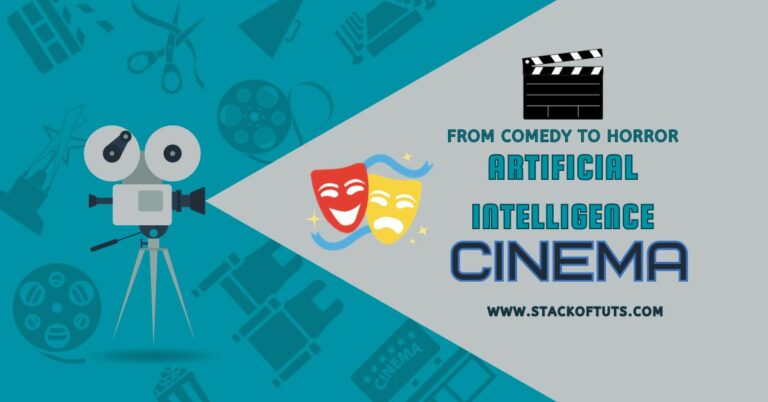
In the contemporary world, the fusion of technology and art is no longer a distant dream but a tangible reality. One of the most influential advancements facilitating this blend is Artificial Intelligence (AI). In the realm of the theater, AI’s influence is profound, creating ripples of innovation and new avenues of creativity. Let’s delve into the multifaceted ways in which Artificial Intelligence is Used in the theatre is enhance the theatrical experience for both artists and audiences.
Why is Artificial Intelligence Used in the Theatre?

AI-powered writing tools help playwrights generate fresh ideas. The techniques can find patterns and trends in enormous amounts of data like plays, scripts, and novels. This material can inspire characters, stories, and conversation.
AI can also build VR and AR experiences for theatergoers. These technologies can take audiences to new realms and provide intriguing new ways to participate in the show.
AI streamlines operations and cuts costs. AI-powered chatbots may answer audience questions and make recommendations. This lets theatre staff focus on customer service and marketing.
AI also improves the audience experience. Theatergoers can receive personalized recommendations from AI based on their ticket purchases and preferences. This can assist theatergoers in finding new performances they’ll like.
10 Best ways that AI is changing the cinema theatre
we’ll explore the top 10 ways Artificial Intelligence is Used in the theatre.
1. Script Writing and Plot Development
AI algorithms, trained on vast databases of literature, plays, and scripts, are now capable of aiding scriptwriters in developing plots, dialogues, and characters. By analyzing patterns, themes, and structures, AI can provide insights or even generate initial drafts, as a collaborative tool for writers to refine their narratives.
- AI Playwrights: There have been experiments where AI has been trained on various plays to generate new scripts. While they might not have the depth or nuance of a human-written play, it’s an interesting frontier of artistic exploration.
- Script Breakdown: AI can analyze scripts to break down character interactions, and emotional arcs, or even predict audience reactions.
2. Enhanced Set Design and Visualization
Modern theaters are utilizing AI-driven tools to create dynamic set designs. Through machine learning models, AI can suggest set modifications, lighting changes, or even entirely new designs based on the theme, era, or mood of the play. Furthermore, augmented reality (AR) powered by AI can be used for virtual set walkthroughs, offering a preview of the actual performance environment.
- Virtual Reality and Augmented Reality: With AI-powered VR and AR tools, set designers can visualize and modify stage designs in a virtual space before building them.
- Dynamic Lighting: AI can control and change lighting in real-time based on the ongoing performance, ensuring perfect synchronization.
3. Real-time Audience Engagement Analysis
By deploying facial recognition and emotion detection systems in theater spaces, it’s possible to gauge real-time audience reactions. Such insights are invaluable for directors and performers, allowing them to adjust pacing, tone, or delivery to better resonate with their audience.
- Personalized Experiences: AI can analyze audience preferences and customize theatrical experiences, perhaps by recommending shows or even altering aspects of a performance.
- Chatbots: AI-powered chatbots can provide information about the show, answer FAQs, or even engage in interactive storytelling.
4. AI-driven Sound and Music Production
Soundscapes and background scores are essential to a play’s ambiance. AI tools can analyze a script’s emotions, pacing, and themes to suggest or generate fitting music tracks automatically. These tools can also adapt in real time, adjusting the score based on the ongoing performance or audience reactions.
- Adaptive Music: AI can generate or modify music in real time based on the mood or tone of the scene.
- Voice Modulation and Effects: AI can change actors’ voices in real time, creating unique sound effects or characteristics.
5. Dynamic Character Interactions with AI Avatars
In some avant-garde theater productions, actors are sharing the stage with AI-driven avatars or holograms. These digital entities can interact with human actors in real time, driven by AI algorithms that enable spontaneous reactions, dialogues, and movements.
6. Enhancing Training and Rehearsals
AI can be a potent tool during the rehearsal phase. Actors can interact with AI-powered systems to receive feedback on their performance, diction, and emotional delivery. Such systems can also simulate audience reactions, preparing actors for various audience types and responses.
- Feedback Tools: AI can watch rehearsals and provide feedback on actor positioning, voice modulation, or other aspects.
- Voice Coaches: AI tools can help actors modulate their voices or adopt accents.
7. Personalized Theater Experience for Audiences
Theaters equipped with AI systems can offer personalized experiences to attendees. Based on prior viewing history, preferences, or even real-time reactions, AI can suggest upcoming plays, offer tailored promotions, or even adjust seating arrangements for optimized viewing.
8. Ticketing and Sales
Artificial intelligence, when combined with big data analytics, can revolutionize the way theaters handle promotions and ticketing. By analyzing audience demographics, preferences, and buying patterns, theaters can design targeted promotional campaigns, offer dynamic pricing, and ensure maximized seat occupancy.
9. Archiving and Digital Restoration
The history of theater is rich and expansive. AI-driven tools are being used to archive old scripts, photographs, and recordings. Moreover, they can digitally restore old footage or audio recordings, ensuring that the golden classics of theater are preserved for future generations.
10. Marketing and Promotion
The definition of a ‘play’ is evolving, from interactive plays where AI systems determine the plot based on audience reactions to performances using AI-generated poetry and dialogue.
- Targeted Marketing: AI can analyze potential audiences and tailor marketing campaigns for maximum impact.
- Content Creation: AI can assist in creating promotional content, trailers, or highlight reels.
The Future of AI in Theatre

Although artificial intelligence is still in its infancy, it already holds the promise of transforming the performing arts. Artificial intelligence (AI) can aid theatres in attracting new audiences by helping playwrights craft more compelling scripts and stage designers develop more original sets.
FAQs
AI in cinema aids in script generation, enhances visual effects and personalizes viewer recommendations for a tailored movie experience.
AI in entertainment tailors content recommendations streamlines production processes, and creates immersive interactive experiences for audiences.
The future of AI in the film industry promises personalized movie recommendations, advanced CGI enhancements, and efficient film production workflows.
AI in cinema theaters enhances movie experiences by personalizing recommendations, optimizing visuals and sound, and streamlining operations for better audience engagement.
Conclusion
In conclusion, integrating Artificial Intelligence in the theatre is not just an enhancement but a revolution. It’s reshaping how plays are written, produced, performed, and experienced. As AI continues to evolve, one can only imagine the myriad of possibilities it will introduce, further enriching the world of theater.
Thanks!





